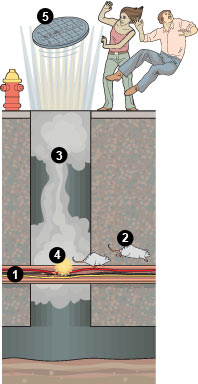
How hot was it during the recent heat wave? Hot enough to pop dozens of the city’s 250,000 manhole covers. It’s a recurring semi-apocalyptic summer event here, sometimes with serious side effects. After one exploded in the Bronx on July 27, six people were sent to the emergency room for smoke inhalation. Ten days earlier in Queens, a cover was launched with enough force to set fire to two cars and cause the wiring overhead to catch fire. So how does it happen?
The copper electrical wiring (1) running beneath the streets is hung on the manhole walls and sheathed in insulation, which can crack and warp owing to age (many are 60 years old), chemical corrosion (a major culprit is road salt, which is carried down with rain), or hungry rats (2).
Cables carry an average of 13,000 volts. With demand up, the cables have to carry more power and begin to heat up. This heat, coupled with the electricity leaking through the cracks in the wiring, starts to burn the insulation.
Carbon monoxide, an extremely flammable gas, is released from the smoldering insulation and collects in the empty chamber (3) ; the cover is pushed up like a lid on a pot of boiling water.
An electrical spark (4) can ignite the gas. This is surprisingly common: In one 24-hour period in July, the Fire Department reported 25 manhole explosions in Astoria. Not all result in the covers being shot into the air (5): That depends on how much gas and electricity is involved. But some covers have been flung over 50 feet.
The explosion knocks out the circuit, often resulting in power outages. “They try to make it look like it’s just the high volume from electricity, but it’s really that the system isn’t kept properly,” says Ariel Antonmarchi, a former Con Ed employee who’s suing the company, claiming he was unjustly fired for being a whistle-blower.
Next: The Lettuce-Based Midtown Meat Market
Have good intel? Send tips to intel@nymag.com.